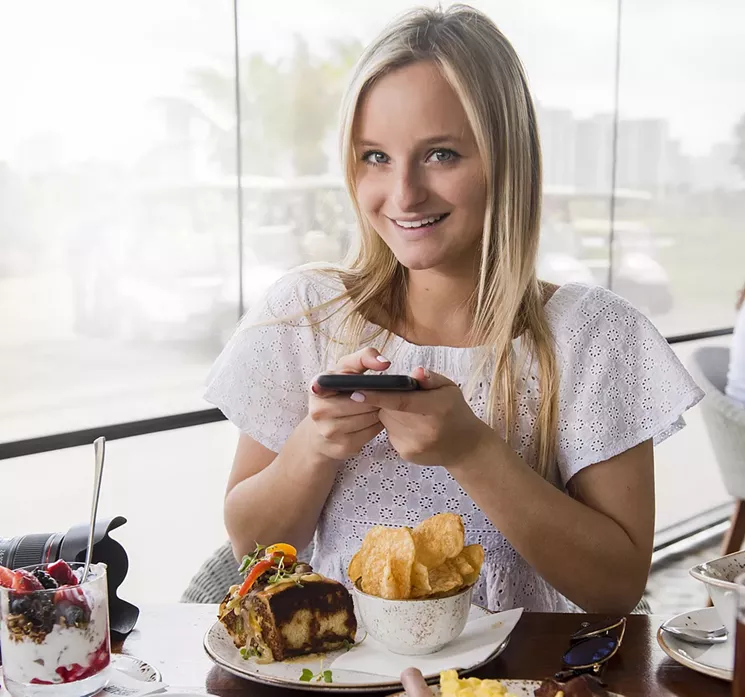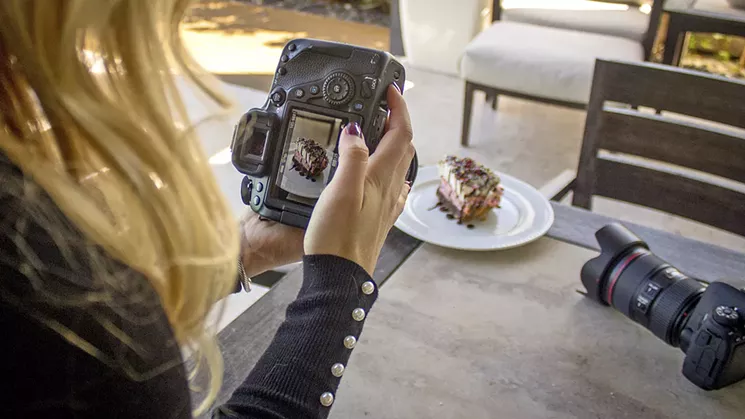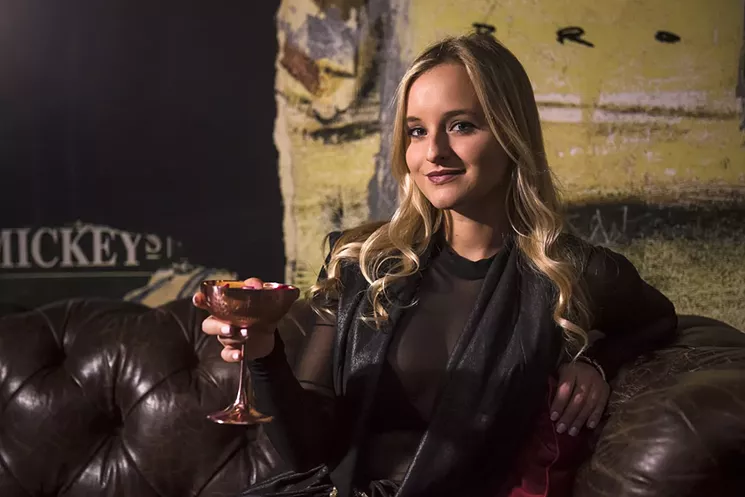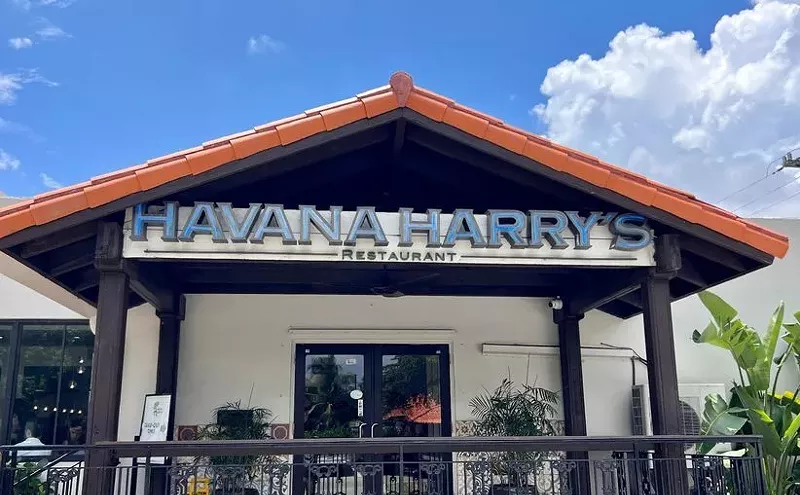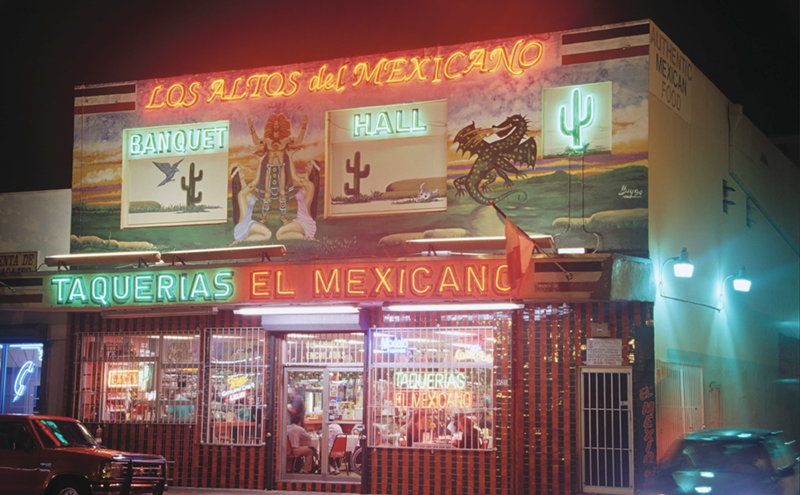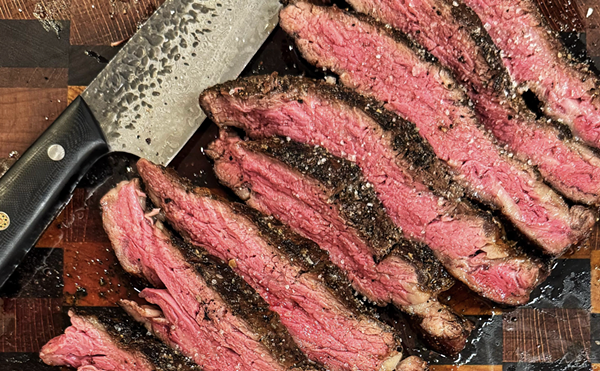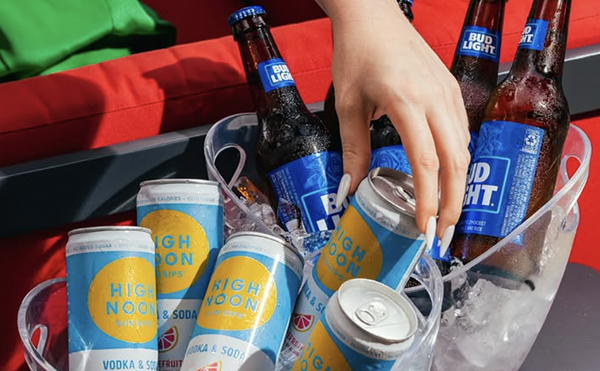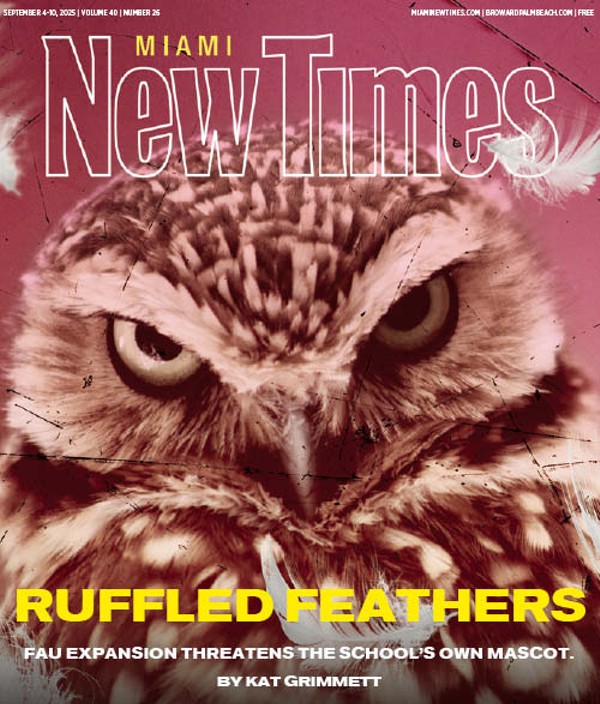It's about noon on a cold Thursday in January when Samantha Schnur, a pretty 24-year-old blonde, pulls up to South Beach's Delano Hotel in her 2016 Porsche Cayenne SUV. She scoops up her $3,500 Louis Vuitton purse with a $1,300 Canon EOS 6D inside, leaves her keys with a bronzed valet attendant, and walks inside. She waltzes past the concierge desk and heads straight to Leynia, a swanky Argentine restaurant where a prime steak can cost $100 and a plate of lamb goes for almost $40.
After giving the maitre d' her name, she's ushered to a large table on a patio with a spectacular view of the pool and the Atlantic Ocean. A few minutes later, she's served — free of charge — a sizzling plate of provolone cheese, a platter of empanadas, truffle Parmesan French fries, and an eight-ounce churrasco.
But Schnur doesn't take a bite. Almost immediately, she removes her camera from the sleek purse and begins snapping pictures. She's careful to avoid shadows, and the bright sunlight — indirect, of course — obviates the need for a flash. For 15 minutes, she snaps the plates from various angles, about 30 shots each. Her just-finished-college countenance is all business.
She barely looks at the pictures as she shoots them. Instead, she glides around the table casting a critical eye like a sculptor considering her work or a wolf examining its prey. By the time she's done, the food is cold. She nibbles on a few French fries, gulps down one tiny slice of steak, and bites into an empanada.
"Once you've touched something 400 times, it's hardly edible," she says. "There's a lot of hands in the food. If it were up to me, I'd have a salad."
A couple of hours later, sitting at a table in Wynwood, Schnur sorts through the photos and finds one she really likes. It's a closeup of the golden-brown truffle fries sprinkled with a heap of shaved Parmesan. She uploads it to Instagram.
A second later, one "like" comes in. "How much engagement a post receives in the first minute determines everything," she says.
Sixty seconds in, there are seven likes. Two minutes, and she's up to 15. "Shit," she says with a look of horror firing from her eyes. "It's doing really bad."
At 3:15 p.m., she deletes the photo. Her face is flushed. "It should already be up to 100 likes," she says. "If they don't like a photo, that ultimately controls my life."
Schnur is a not just any Instagrammer, but a member of an elite club of food photographers who can earn thousands of dollars for posting a single picture of a soufflé or branzino. In 2015, Cosmopolitan published the online list "15 Food Instagram Accounts You Need to Follow Immediately." Schnur was number eight. The Florida State dropout (and University of Miami grad) has 645,000 followers on her Instagram page, the Naughty Fork, and 185,000 likes on a Facebook account under the same name. At least one of her Instagram videos (showing the preparation of waffled mozzarella-stick pizza) has been played 14 million times. She has earned as much as $4,000 for a single post, and she recently scored deals with major corporations such as Oreo, Amazon, and Arby's, along with local businesses including Pincho Factory, El Patio, and Honeybee Doughnuts.
Last year, she brought in almost $100,000, and this year she hopes to earn at least twice that amount.
Philippe Khalifa, owner of El Patio in Wynwood, recently paid Schnur $500 for two hours of filming a new cocktail and a hot dog and then posting a few seconds of video. "Working with Sami is our way of showing 645,000 virtual people that our bar serves food," he says. "Where else are you going to find that?"
Centuries before Instagram pictures of avocado toast and gooey mac 'n' cheese, the Dutch master painters' iconic still lifes transformed the way people saw food. Then there was the iconic photograph of a basket overflowing with fruit taken in the 1830s by William Henry Fox Talbot, a British scientist who fathered the negative-positive photographic process.
In the 1940s, brands such as Crisco and Aunt Jemima began to circulate free pamphlets with recipes and food photographs called cookbooklets. Then, in the early 1990s, a volume of recipes titled White Heat was published. It included photos that were works of art and overshadowed the words.
In the 2000s came the food bloggers. Ruth Reichl, former editor of Gourmet magazine and food-writing royalty, began detailing her personal experiences with restaurants, cookbooks, and food in 2007. Daniel Vaughn visited and blogged about more than 600 barbecue spots across the nation, which earned him a role as Texas Monthly's first barbecue editor.
"We all think about eating," says Katy Coffield, founder and CEO of Foodie Tribe, a Miami-based food and drink marketing agency that pairs more than 1,500 influencers with big brands such as McDonald's and Dove Chocolate. "Food has a natural appeal, so it makes sense that it has translated onto our screens."
In Miami, Sef Gonzalez started the blog Burger Beast in 2008. It began as a news site but quickly transformed into a paean to Miami comfort food.
"I would get told to put my camera away in restaurants," says the stocky 43-year-old, who sports a spiky beard. "I got kicked out of a Burger King once when I was trying to take photos of their remodel. And, don't forget, I was using a little digital camera at the time."
Then, in 2010, came Instagram. It was a new way to communicate visually around the world. Unlike Facebook or Twitter, it prioritized image over text.
By March 2012, there were nearly 30 million registered accounts. That's when Facebook acquired the platform for $1 billion. By 2015, Instagram had rolled out a host of business and advertising tools that allowed account owners to pinpoint their followings and promote posts.
"I worked with Whole Foods and made $10,000 in a week by posting a video and a photo."
tweet this
In 2016, the app added live video broadcasting, a feed-ranking algorithm, and messaging features, all in an effort to compete with other platforms such as Snapchat. Today, Instagram boasts more than 800 million accounts, with about 500 million active daily users.
Celebrities dominated from the beginning. Selena Gomez, Ariana Grande, and Beyoncé have long been among the most followed and liked. In 2017, Lele Pons, a YouTube and Instagram star who only two years earlier had graduated from Miami Country Day School, was named to Forbes' "30 Under 30" list. She was "the most watched Instagram Stories creator of 2017," the magazine said, referring to a feature that allows users to upload real-time videos similar to Snapchat.
These days, British chef Jamie Oliver has among the most popular food accounts on Instagram. By posting recipe videos, restaurant photos, and family shots, he has gained more than 6.2 million followers.
Then there's Foody Fetish, a Miami-based Instagram account with more than 2.5 million followers. Started in 2015, it's run by Yanni Georgoulakis, a fit and clean-cut 33-year-old who spends weekdays as a sales rep for the pharmaceutical company UCB. When he's not in the office, he posts photos and videos of exaggerated food items, from grilled-cheese cakes to five-patty cheeseburgers. Sometimes he's paid to post, but for now, that income stream is not reliable enough to allow him to quit his full-time gig, he says.
"I worked with Whole Foods in May 2017 and made $10,000 in a week by posting a video and a photo for their Easter promotions," he says. "But then it was over. It's hard to make it stable."
Large followings can equate to hefty sums of cash. Because of the attention elite Instagrammers command, the value of sponsored posts can range from $700 to more than $50,000. Those with at least 500,000 followers average anywhere from $2,000 and $5,000 per photo. In 2016, about $570 billion was spent on influencer marketing, according to eMarketer, a market research company that digs into digital media and commerce trends. An influencer can expect about $100 per 10,000 followers.
As more Influencers have secured sponsorship deals, the Federal Trade Commission has cracked down on disclosure. Agency guidelines state Instagrammers who are paid to post must "clearly and conspicuously" publicize their relationships to brands when promoting them. That usually means the hashtag #ad or #sponsored must be included in the caption's first three lines.
Though an account might appear popular, it's not always genuine. Some influencers have been caught paying hundreds of dollars for fake likes and followers of "bot" services, which make up 8 percent of all Instagram accounts, according to a recent article in Business Insider. But it's difficult to track who's using them and who isn't.
It's also important for restaurants that pay Instagrammers to track the location of followers. "You have to look at the engagement and see where the following is coming from," says Matt Brooks, who is founder of the Miami marketing agency Alchemy and works with local influencers such as the Naughty Fork. "Someone in Miami with 100,000 followers with 30 percent from India doesn't match up."
Once an agency or a business identifies a viable influencer, the results can be huge. "Restaurants and brands are more aware than ever that presentation is important," Brooks says. "We used to look at televisions or movies... but now you have phones. That's what everyone is looking at."
In early 2014, Samantha Schnur was a serious premed student in Tallahassee, just a couple of years out of the exclusive Ransom Everglades School. While studying for exams, she got hungry one night and flipped a stack of rainbow pancakes in her dorm's communal kitchen.
"My roommates were going out, but I decided to stay in and study," she says. "I ended up playing around on Instagram all night instead."
She set up an account called "Oops I Ate It Again." A few days later, she changed the name to "McDiet." A week after that, she settled on "The Naughty Fork."
The name stuck, and she began posting dozens of photos of over-the-top foods, such as hot dogs wrapped in bacon and smothered in mac 'n' cheese. "It wasn't all necessarily edible," she laughs, "but it was crazy to look at. No one had seen this stuff before. I was documenting food in a new way."
After two months, she had 10,000 followers. "It was a huge joke in the beginning," Schnur says. "Everyone was calling me a fat-ass. It wasn't until I hit 30,000 followers about four months later that people stopped laughing."
She grew up on Palm Island in Miami Beach, where some homes sell for more than $30 million. She lived with her mother, Donna Peyton, and her father, Dr. Steven Schnur, a cardiologist and author who founded Elite Health, a medical and wellness company with offices in Miami Beach, Davie, and Sarasota.
"She was eating sushi at age 3," says her mom, who at age 54 looks strikingly similar to her daughter, with fair skin and light-blond hair. "Whatever I cooked, she would eat it."
When her parents divorced in the late '90s, Samantha split her time between them while attending Ransom. She and several friends at age 15 created Tumblr accounts. But Samantha amassed more followers than the others — 30,000 in eight months — by reposting photos of grungy fashion, gloomy landscapes, and moody quotes.
"My Tumblr was really dark," she says, "nothing like what you would expect from me. But it was what people loved on the internet at the time. I realized that if you post photos that people want to see, there was a way to gain a following from that."
When it was time for college in 2012, Samantha chose Florida State University. She first majored in business and then switched to premed. "I always knew medicine wasn't what she really wanted to do," her dad says. "Growing up, she had such an outgoing personality. She was always very visual. I saw her as someone who could become an entrepreneur."
After setting up the Instagram account while studying for exams, Schnur knew she was onto something. Though it began as a distraction from school, she quickly came to believe she could make money from it.
"There's something to be said about having thousands of followers," Schnur says. "If I post something, they see it. It's a large audience that I basically have control over."
"I was sleeping, and I woke up with 102,000 followers. Then it totally blew up."
tweet this
One of her best friends at Florida State was Jenny Delgado, a business major, who was Schnur's pseudo-assistant during the account's early days. "Every time we went to eat or order in, Samantha would take a photo and post," Delgado remembers. And then one day to the next, it just blew up."
Even as she studied chemistry and biology for three years at FSU, Schnur spent hours making do-it-yourself recipe videos of s'mores cookies and greasy burgers and then posting them on Instagram. Soon she had about 60,000 followers.
The summer before her senior year, in 2015, she went on a two-week family vacation to Mykonos, Greece. She was bored with FSU and wanted to begin something new. "How are you supposed to tell your parents that you're going to quit school for Instagram?" she says.
One afternoon at a restaurant with blaring club music and free-flowing booze, Schnur mustered up the confidence to tell her dad of her intention. She yelled across the table: "Dad, I'm not going back!"
"He gave me a thumbs-up, and that was it," she says.
So she moved back into her father's house on Palm Island and took the Naughty Fork full-time. "She knew from day one that she would monetize it," Dr. Schnur says.
Less than a month later, in August 2015, Cosmopolitan published "15 Food Instagram Accounts You Need to Follow Immediately." Schnur made the cut.
"I was sleeping, and I woke up with 102,000 followers," she says. "Then it totally blew up. At that point, food Instagrams were an untapped market. There weren't that many of us."
While running the Naughty Fork, she enrolled at the University of Miami in spring 2016 to finish her biology degree. When she wasn't in class, she was running to restaurants to photograph and film. When she graduated in May 2017, her account had boomed to more than 600,000 followers.
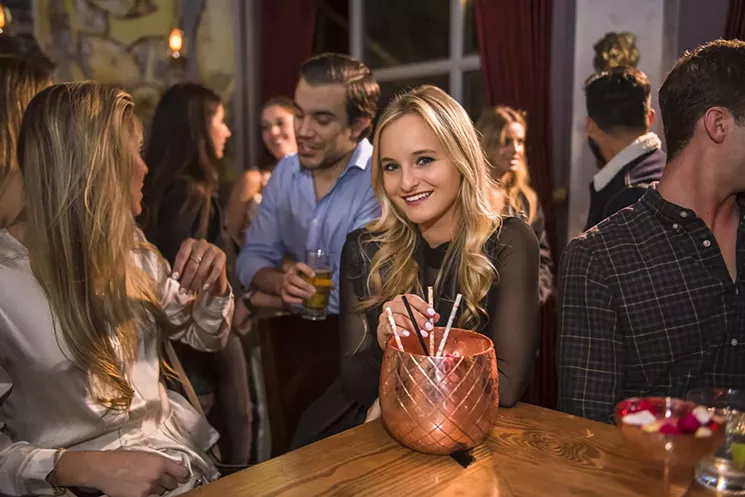
At 10:55 a.m. on a Thursday in January, Schnur is working in the kitchen of her dad's $6.8 million, 5,600-square-foot home on Hibiscus Island in Miami Beach. Out back, small speed boats and large yachts float by on the bay just feet from a long infinity pool. When a van pulls in front and the doorbell rings, her colossal golden retriever, Kingston, dashes to the door and stares through a large window. Schnur, wearing a black long-sleeve shirt and dark skinny jeans, pushes the dog to the side and greets a delivery driver.
After collecting a large plastic bag branded with a sticker from Fireman Derek's, the famous Wynwood pie shop, she walks to a table, opens the bag, and pulls out two slices of pie. One is cookies and cream. The other, called sundae, is topped with pink frosting, heaps of whipped cream, and fudge.
"There's something missing," she says with a sigh. "They need more."
She places the pieces of pie on two sparkling white ceramic plates, smooths out the sides for five minutes with a knife, and adds rainbow sprinkles and Hershey's chocolate sauce. She takes the pie outside and snaps nearly a hundred photos before posting one on Instagram. Within two days, it has garnered 6,281 likes.
For many posts like this one, Schnur doesn't earn a dime. But attracting an audience and keeping it is all part of the process of growing her business. "It's a give-and-take," she says. "I can afford to order food from Fireman Derek's just for the sake of my Instagram because I have other clients that are willing to pay me $500 for a video."
That afternoon, after Schnur's meal and photo shoot at Leynia inside the Delano, she drives to El Patio in Wynwood. Philippe Khalifa, the tall and lanky owner with short dark hair, wants Schnur to promote the bar's new happy hour.
She wastes no time once she arrives. She quickly pulls out her camera and throws her Louis Vuitton purse on the floor next to a barstool. She spends 15 minutes filming an employee squeezing ketchup and mustard onto a hot dog and another ten minutes focused on a bartender shaking and mixing a fruity flamingo-pink cocktail.
"I've seen her following grow exponentially in the last few years," says Khalifa, who has worked with Schnur since he opened the bar in 2016. "Her followers trust where she's going and what she's posting. People come in all the time and say that they saw us on her account. It's an amazing marketing tool."
Once Schnur finishes at El Patio, she stands on the sidewalk outside the bar and opens Instagram on her iPhone X. An hour after she gave up on the shot of Leynia's truffle fries because it drew only a few likes, she tries again. This time, her photo quickly racks up thousands. (In 24 hours, it has 14,588, better than average for the Naughty Fork.) "It's so random," Schnur says. "I really couldn't tell you why posting it at 4:15 p.m. instead of 3:15 p.m. would make such a difference. That's what I'm working with here. I literally never know."
Next, Schnur walks down the block from El Patio to Taiyaki, the famed New York ice-cream shop that recently opened an outpost in the 1-800-Lucky food hall on NW 23rd Street. She strolls past the neon cat at the entrance and up to a glass booth, where a teenage employee wearing a black apron is serving fish-shaped cones. She opens her phone and pulls up an email explaining she is entitled to a free unicorn ice-cream cone in exchange for a post.
Once the young employee realizes Schnur is the Naughty Fork, he offers her two variations and anything else she'd like on the house. She declines but asks to photograph servings of matcha green tea and black sesame.
"I try to post things people can relate to," she says. "The dirtier and more indulgent it looks, the more response you'll get."
As the ice cream melts, Schnur marches around 1-800-Lucky in search of good lighting. She finally settles on a white wall, holds the cone up to her lens, and snaps at least a hundred photos.
"So many of my friends say, 'Oh, Sami, your job is like a dream,'" she says. "I get it. They have to sit in a 9-to-5 and do something they don't necessarily want to do. But being told what to do is a lot easier than actively having to run around and find it yourself."
When the day is over, Schnur climbs back into her Porsche SUV and heads home to Hibiscus Island. She replays each step of the day. She made $500 from El Patio, she says, and $300 from Leynia. "Sometimes this whole thing gets stressful, but days like these prove that it pays off."
A week later, sitting in the dining room of her dad's house, she watches the sun set and relaxes on a plush white sofa near a massive, 20-foot-tall Christmas tree left over from the holidays.
Then, suddenly, her bluish-green eyes widen. Schnur remembers she forgot to deposit a check. She reaches into her purse and pulls out a half-ripped white envelope. Inside, $4,000 is written on the front.
"That brings [January] to $18,000," she says. "It's been a good month."
Though Schnur is by contract prohibited from saying exactly how much she earns per post from each company, she details how the month played out. On January 2, she spent two hours posting videos and photos about Amazon's New Year's deals on food appliances such as slow cookers and blenders. A single January 5 photo post of mini chocolate doughnut bites dusted with white sugar at Arby's earned 15,128 likes.
On January 27, she uploaded photos of a double bacon cheeseburger and a mac 'n' cheese skillet to promote Gulfstream Park's luxury horse race, Pegasus World Cup. Together, those posts earned nearly 20,000 likes and hundreds of comments.
She's set to post content for Miami Grill, Oreo, Arby's, Dairy Queen, and Amazon.
tweet this
Before the month was up, Schnur ordered a grilled mahi-mahi caesar salad at a Miami Grill drive-thru. She took it home to Hibiscus Island and shot 50 photos of the emerald-green lettuce bowl. Then she sent her favorites to the company. Though she has yet to hear which ones to upload, she was paid in advance.
"All of these brands have public-relations companies that reach out to me and ask to work together," she says. "I've never actually spoken to anyone at Amazon or Oreo... but they must be happy because they've all asked me for more work this year."
Her client roster has grown quickly. In the next six months, she's set to post content for Miami Grill, Oreo, Arby's, Dairy Queen, and Amazon, she says. The contracts include the number of posts, what each should depict, and a flat rate regardless of engagement.
But with all of that money and responsibility comes a growing pressure to guarantee an audience. Though her clients generally don't require a specific number of likes or views, there's an expectation that new posts will perform the same or better than previous ones.
"People might follow me, but I have no idea what they really like," she says. "Maybe one of them likes burgers and another likes pizza. Sometimes I get 20,000 likes; other times I barely reach 4,000."
According to her profile's metrics, which anyone can view on Instagram, 67 percent of her followers are women. Approximately 63 percent of them are between 18 and 34 years old. A large chunk, about 45 percent, is in New York. Another 40 percent is in Miami. Less than 10 percent are in Los Angeles, with the rest scattered across Europe in countries such as England and France.
Does she always caption her paid posts with #ad or #sponsored, as the FTC requires?
"I only do it with big companies like Amazon or Oreo," she says. "But if it's a small business or doesn't really look like an ad, I won't caption it. I honestly support everything I post, paid or not. I won't post something I think is genuinely bad even if they offer payment."
Schnur is not sure how long her social media fame will last. She talks about growing the Naughty Fork into a full-fledged media company with an app and a more sophisticated website. But for now, her website is outdated, and her app has yet to launch.
"If Instagram dies tomorrow, it's all gone," she says. "It's scary to know that, right now, I'm just relying on an app."



